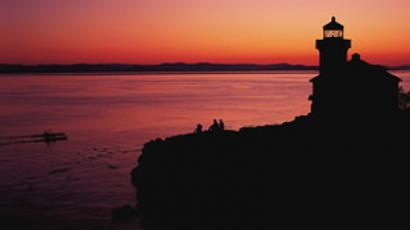Spitsbergen: A Norwegian island with a Russian flavor
Officially under Norwegian jurisdiction, the Svalbard archipelago in the Arctic Circle has a particular status for Russia, as it has the right to carry out business on the archipelago.
Svalbard archipelago lies beyond the Arctic Circle, nearer to the North Pole than it is to mainland Scandinavia, making it one of the most remote places on Earth.
On the archipelago’s island of Spitsbergen there are two towns: Russia’s Barentsburg and Norway’s Longyearbyen. The two are the only large settlements located within miles of each other, but they are worlds apart.
At the turn of the last century it was thought Spitsbergen might hold some of the world's richest coal seams, which led to an international coal rush.
In contrast, the Soviet settlement was intended as a model town in the image of its parent country. A concert auditorium, a sports hall, and a large kindergarten were all built at great expense.
As it turned out, the coal mines on Spitsbergen never made a profit, but Barentsburg became a symbol of Soviet might. Now it stands as a perfectly preserved slice of a country that no longer exists.
Longyearbyen's past is also celebrated with a statue of a miner right in the center of town, but its present definitely lies elsewhere. By the 1970s it was a non-economically viable mine populated by a Norwegian community of male contract workers. The authorities realized change was needed.
Today, a small but thriving bar scene provides entertainment for wealthy tourists looking for an exclusive experience. Many stop there on their way to the North Pole. With a striking locale, the island of Spitsbergen is home to one of the world's largest polar bear populations.
In neighbouring Barentsburg a bust of Lenin may be just an old relic, but the Soviet past can be seen in almost every aspect of its citizens' lives. Most workers' families live in a single room, with a tiny kitchen.
In Soviet times, there was stiff competition to go there. Now, there are fewer applicants. The population of the town has declined from more than 2000 to about 800 in twenty years.
Workers get their wages, pay rent, and buy their food from a single company that runs everything in Barentsburg.
“It would be a lie to say that I came here for the adventure. I came for the money. Also, they told me that they have a lot of musical events here, and I would be able to realize my lifelong passion,” says Ivan Vagulich, who came to Spitsbergen from Ukraine on a two-year contract as a mine electrician.
Thanks to legislation that allows any foreigner to work without a visa, Norway’s Longyearbyen has become a magnet for immigrants from all over the world, like two cousins from Rio de Janeiro who opened a restaurant serving traditional Brazilian cuisine.
“It's difficult because it is a small town. We come from a big town of Rio and it's very different. But it is also nice, the people here like a family, really nice,” shares restaurant owner Diane Freitas.
The heads of the Russian and Norwegian authorities on the island see its future in a different light.
“If only we manage to increase the volumes of coal produced, eventually I am sure it will be profitable,” says Russian consul Vyacheslav Nikolaev.
“Svalbard is so unique that it will always be an attraction to people who are willing to pay at least some money to come to Svalbard,” insists Stein Pettersen, Governor of Svalbard.














